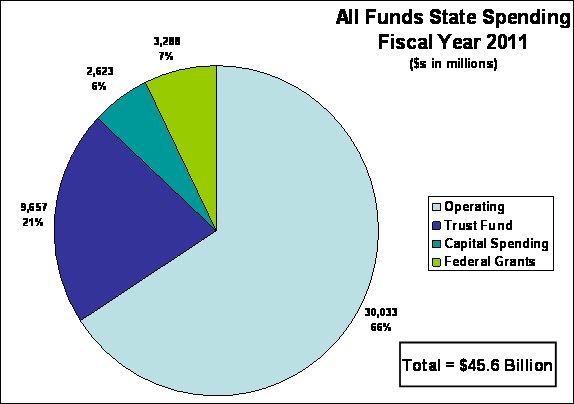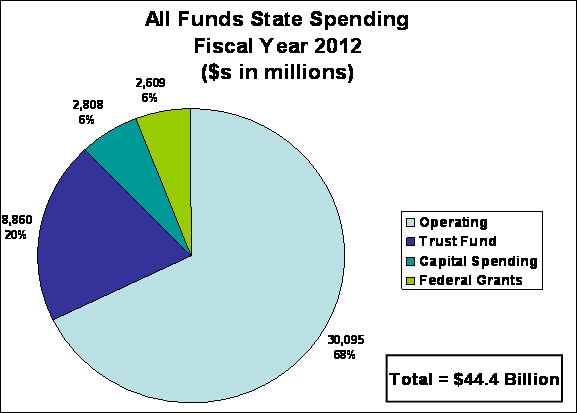Financial Statement Overview
Comprehensive State Spending
When considering the Governor’s recommendation for the
fiscal year 2012 budget it is important to remember that the funding levels
proposed in House 1 do not encompass the entire Massachusetts state spending
for next year. In fact, a substantial amount of state spending every year is
done “off-budget”, or through fund sources that are not subject to the annual
appropriations adopted by the Legislature. The spending that is done by the
state from non-operating sources falls into three general categories:
- Federal Grants – Annually the federal government
provides billions of dollars in funding to state agencies to operate
programs, whether ongoing or one-time, for a variety of purposes; housing,
public health, environmental health, education and public safety. State
agencies are responsible under state law for notifying the Legislature and
the Executive Office for Administration and Finance of their intent to
apply for these funds, but are otherwise given flexibility in the timing and
purpose of the expenditure of these funds. Most federal grants require
rigorous reporting standards with which applicant state agencies must
comply. A large portion of the spending provided to Massachusetts through
the American Recovery and Reinvestment Act (ARRA) has been expended
through federal grant accounts. The House 1 fiscal year 2012
recommendation provides projected spending amounts for federal grants for
each department in the Appropriation Recommendations section.
- Trust Funds – Most state agencies have established
trusts to be held on their behalf by the state treasurer into which they
are directed in law or through a trust document to deposit revenues made
available to the agency for dedicated purposes and restrictions. In
general, any unexpended funds in state agency trust funds from one fiscal
year to another remain in the appropriate funds, made available in future
years for further expenditures. Projected spending amounts for trust funds
are listed for each department following in the Appropriations
Recommendations section.
- Capital Projects – Every year the state must spend
billions of dollars to support require maintenance and improvement to its
transportation infrastructure, housing developments, state parks and
environmental projects, and investments in higher education institutions.
While this spending is authorized by the State Legislature, the
appropriations are generally in effect over a five-year period, in
recognition that many capital projects must span multiple fiscal years,
from project inception to completion. Most capital projects spending is
funded through bond sales, which allow the state to finance large scale
projects through borrowing and paying annual debt payments, much like a
family would sign a mortgage loan for a house. Please see the Capital
Budget section in this document for further discussion of capital projects
spending.
As shown by the charts below, the annual state operating
budget makes up the largest portion of annual state spending in comparison to
all funding sources in any given year. Yet over 30 percent of total state
spending occurs from non-budgetary sources. In the financial statements
following this discussion, only the operating budgeted fund revenues and
expenditures are displayed. It is important to note that, however, that there
are further resources that annually available to the state and its agencies
beyond those subject to the annual budgeting process.






